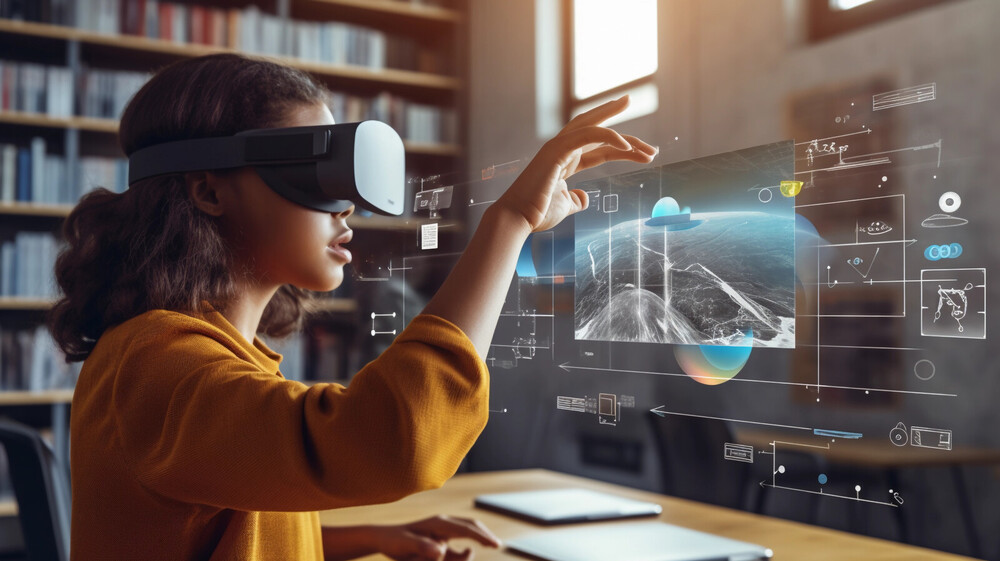What is Virtual Reality (VR)?

What is Virtual Reality (VR)?
Virtual Reality (VR) is an immersive technology that creates a simulated environment, allowing users to interact with and experience a computer-generated world. Unlike Augmented Reality (AR), which overlays digital content onto the real world, VR completely replaces the user’s surroundings with a virtual environment. This technology engages multiple senses, providing a sense of presence and realism that can transport users to different locations or scenarios.
This article explores the fundamentals of virtual reality, its applications, benefits, challenges, and the future of this exciting technology.
Understanding Virtual Reality Technology
VR technology relies on a combination of hardware and software to create a fully immersive experience. Key components include:
- Head-Mounted Displays (HMDs) – VR headsets, such as the Oculus Rift, HTC Vive, and PlayStation VR, are essential for experiencing virtual reality. These devices contain screens that display the virtual environment and sensors that track head movements, allowing users to look around and interact within the virtual space.
- Controllers and Input Devices – VR systems often come with handheld controllers or motion sensors that allow users to interact with the virtual world. These devices enable users to grab objects, navigate menus, and perform actions within the simulation.
- Audio Systems – Spatial audio enhances the immersive experience by providing 3D sound that changes based on the user’s movements and position within the virtual environment. This realistic audio adds depth to the experience.
- Software – VR applications and games are developed using specialized software that creates and renders the virtual environments. These programs can simulate realistic physics, animations, and interactions, providing users with engaging experiences.

Applications of Virtual Reality
Virtual reality has a wide range of applications across various fields. Here are some notable examples:
- Gaming – VR gaming is one of the most popular uses of the technology. It allows players to enter immersive worlds, interact with characters, and experience gameplay in a whole new way. Popular VR games include Beat Saber, Half-Life: Alyx, and The Walking Dead: Saints & Sinners.
- Education and Training – VR is transforming education by providing interactive and experiential learning opportunities. Students can explore historical sites, conduct virtual science experiments, or practice medical procedures in a safe, controlled environment.
- Healthcare – In the medical field, VR is used for training and therapy. Medical students can practice surgical techniques in virtual simulations, while patients can use VR for pain management or exposure therapy to treat phobias.
- Real Estate – Real estate agents use VR to offer virtual tours of properties. Potential buyers can explore homes from the comfort of their own space, making it easier to visualize layouts and designs without physically visiting the site.
- Military and Defense – The military utilizes VR for training simulations that prepare soldiers for real-world scenarios. These simulations can replicate combat situations, enabling soldiers to practice decision-making and teamwork without the risks associated with live training.
- Travel and Tourism – VR allows users to experience travel destinations without leaving their homes. Virtual tours of landmarks, museums, and natural wonders can inspire future trips and provide valuable insights for travelers.
Benefits of Virtual Reality
The adoption of VR technology offers several advantages across various sectors:
- Enhanced Learning Experiences – VR engages users in active learning, promoting better retention of information. Immersive environments can make complex subjects more accessible and enjoyable.
- Improved Training Outcomes – In fields like healthcare and aviation, VR provides realistic training experiences that prepare individuals for high-stakes situations. This hands-on approach increases confidence and competence.
- Increased Engagement – VR captivates users by offering interactive experiences that traditional media cannot match. This engagement is particularly beneficial in education, marketing, and entertainment.
- Accessibility – Virtual reality can make experiences more accessible to individuals with mobility challenges. For example, VR can simulate travel experiences for those who cannot physically visit certain locations.
- Therapeutic Applications – VR has shown promise in therapeutic settings, helping individuals cope with anxiety, PTSD, and phobias. The controlled environments allow for gradual exposure to stressors in a safe space.
Challenges of Virtual Reality
Despite its many benefits, VR also faces several challenges that may hinder its widespread adoption:
- Technical Limitations – The quality of VR experiences relies heavily on hardware capabilities. High-resolution displays and powerful processors are essential for smooth and realistic simulations, which can be costly.
- User Discomfort – Some users experience motion sickness or discomfort when using VR headsets. This issue, known as “VR sickness,” can occur due to a disconnect between visual motion and physical sensation.
- Content Development – Creating high-quality VR content can be resource-intensive and requires specialized skills. The development process can be time-consuming, making it challenging to produce a wide variety of engaging experiences.
- Physical Space Requirements – Many VR experiences require sufficient physical space to move around safely. Users need to be aware of their surroundings to avoid accidents, which can limit the feasibility of VR in certain environments.
- Social Isolation – While VR offers immersive experiences, it can also lead to social isolation. Users may spend extended periods in virtual environments, potentially neglecting real-world interactions.

The Future of Virtual Reality
The future of VR is bright, with several trends shaping its development:
- Advancements in Hardware – As technology progresses, we can expect lighter, more comfortable VR headsets with better resolution and tracking capabilities. Wireless technology will also improve mobility and convenience.
- Integration with Augmented Reality – The merging of VR and AR technologies will lead to mixed reality experiences, where users can interact with both real and virtual elements simultaneously. This integration will expand the range of applications and enhance user engagement.
- Increased Accessibility – As VR technology becomes more affordable, its accessibility will grow. More users will be able to experience virtual reality, leading to broader adoption in various sectors.
- Expansion in Various Industries – VR will continue to find applications in diverse fields such as therapy, architecture, and sports. Its versatility will drive innovation and creativity in how we approach various challenges.
- Social VR Experiences – The rise of social VR platforms will enable users to connect and interact with others in virtual environments. These platforms will foster collaboration, gaming, and socialization, creating new opportunities for community building.
Conclusion
Virtual Reality (VR) is revolutionizing how we experience and interact with the world. By immersing users in simulated environments, VR enhances gaming, education, training, and various other fields. Despite its challenges, the potential benefits of VR are vast, making it a valuable tool for individuals and organizations alike.
As technology continues to evolve, VR will become more integrated into our daily lives, unlocking new possibilities for learning, collaboration, and entertainment. In a rapidly changing digital landscape, virtual reality stands out as a transformative force, reshaping how we perceive and engage with our environment.




